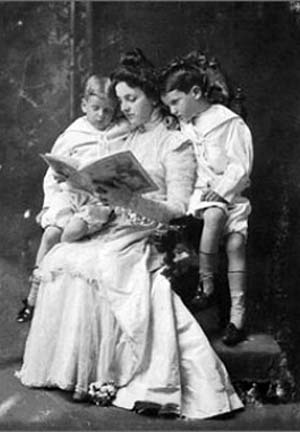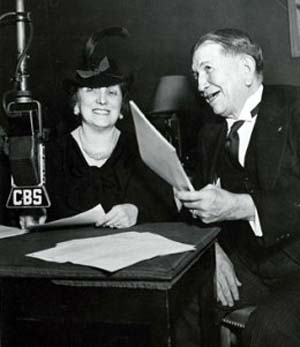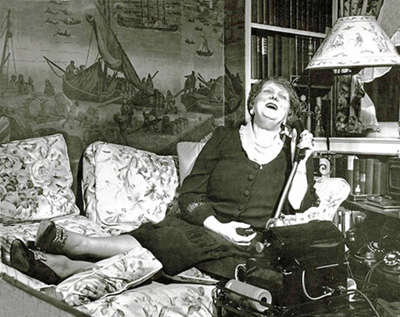 |
Book Reviews
Was Emily Post a Socialist?
Marian T. Horvat, Ph.D.
Book review of Emily Post, Daughter of the Gilded Age, Mistress of American Manners
by Laura Claridge, NY: Random House, 2008, 500 pp.
A reader sent me this question: “I have a very dear Traditional Catholic friend who is teaching six teen-age girls etiquette in her home. She occasionally refers to Emily Post's teachings. Another parent is not happy with this and says that Emily Post was a socialist. Can you please help us with any advice?”
This question motivated me to learn more about Emily Post, whose name became synonymous with American etiquette. I have always had reservations about certain aspects of her books, and certain objections were solidified as I read a 500-page tome by Laura Claridge.
Emily Post’s anti-socialist phase
Born in 1872, Emily Price, daughter of architect Bruce Price and socialite Josephine Wilkes Barre, was a member of the “best society” when American still had a clearly defined upper set in New York. Her parents were Episcopalian, but religion was not practiced in the home.
Her set, which included names we still recognize – the Astors, Vanderbilts, Colliers, Morgans, Collins - was a closed group that socialized at the same clubs, vacationed on “the Continent,” and married among themselves – an American aristocracy. Emily Price’s upbringing set the stage for the future Emily Post to become a U.S. arbiter of how to behave politely. She knew the rules of good society because she was a part of it.
Emily married into the prestigious Post family. All her life, even after her divorce in 1905, she enjoyed an upper class lifestyle. For example, she always had at least two maids, a cook, and a ‘handyman.’ While she insisted her servants be treated well, none – even her longtime personal maid and friend Hilda Ogren – ate at her table. In this regard, she was not egalitarian.
The burgeoning concern at the turn of the century over “social issues” did not interest her. To the contrary, like her father Bruce Price, Emily believed that the less a government interfered in a man’s life and business, the better. Although Emily Post did not drink, she took a public stand against the Prohibition Movement precisely because she thought the government had overstepped its boundaries.
Because she was against the social programs Franklin Roosevelt introduced, she opposed the “New Deal” President and never missed a chance to convey her dislike of his politics. Nor did she like Eleanor Roosevelt, a socialist and feminist, whom she considered “too pushy” about getting things done. (Claridge, p. 290)
As a young woman, she ignored the Suffragette movement led by some of her friends – Anne Morgan and Else de Wolfe – and never campaigned for the right to vote. She stated that a woman’s influence was best exercised by managing the home, and not in the voting booth. In her later years, however, she took a different position and promoted women entering the workplace and expressed pleasure that women had won the vote.
In short, Emily Post was rarely interested in socialist issues, but her leanings were like her father’s – politically conservative and socially liberal, without being socialist.
Divorce and success as an author
Excellent manners were second nature to the popular and beautiful debutante who “came out” in New York society in 1889, met the handsome, urbane Edwin Main Post, a prominent banker and stockbroker, and married him in 1892. The couple had two sons, Edwin Main Post, Jr. (1893) and Bruce Price Post (1895).

Reading to her sons Edwin Jr. and Bruce |
But the “storybook marriage” did not have a happy ending. After a series of affairs with chorus girls and actresses, Edwin’s dissolute life was made public by a blackmailer whom he refused to pay to keep silent. The scandal of her husband’s love affairs was greater than the stigma of divorce, and so Emily divorced him in 1905. She never mentioned his name again, even in her family, but until she died, an extra plate for him was set on the table.
Because Edwin had lost most of his money in shaky stock deals, Emily was left to support her sons in the style to which she was accustomed. Ignoring advice to date and remarry, she instead began to write novels about the upper class and pen articles and serials for magazines. Her golden opportunity came with a request by Funk and Wagnall to write a book on etiquette. With the publishing of her first “blue book” of Etiquette in 1922, the career of Emily Post as the grand-doyenne of American manners was launched.
Etiquette opened up the customs, manners and graces of high society to the newly rich and growing middle class, instructing them how to navigate successfully in society. Which fork do I use? What is the proper way to eat soup? How should I make an introduction? Should I say glasses or cups? (the answer is glasses). How do I address my wedding invitation? These questions Emily Post answered graciously in the best of form. This is, in my view, the strong point of Emily Post’s Etiquette. To know the proper way to do something, one can still refer to her “blue book.”
On an average of every five years until 1955, however, Emily Post issued a revised edition of Etiquette. Each time she “updated” her advice to accommodate the changing customs and social mores of American society. The problem for Catholics is that Emily Post acted as if ethics and morals were relative, that rules should change to accommodate “progress” and the new thinking of the times. This is the weak point of her revised editions.
Censurable points
Emily Post may have been politically conservative, but she was socially much more liberal. As the years passed, she became a champion of the freer manners and customs that were emerging in the 20th century.
For example, her chapter on “Chaperoning” changed radically. In her 2nd edition, she instructed parents to let their daughters date and spend time with prospective beaus unchaperoned. By her 4th edition she proclaimed the need for a chaperone a “vanished custom.” Thus, at a time when conservative Catholic families in Europe and South America held fast to chaperoning guidelines to safeguard a girl’s innocence and reputation, in the United States those rules were flying out the window, thanks in good part to the liberal views of Emily Post.

A popular radio hostess who prided herself as being a businesswoman |
Already in the second edition of Etiquette, Post was accommodating divorce, advising the most tactful ways to deal with previously divorced brides and grooms. The Church instructed Catholics to not even attend such weddings. Many Catholics in the United State chose to follow Emily Post instead. Such was her influence.
She decreed the end of other customs to favor feminism. In her 4th edition, she stated women could pay for themselves when on a date. She also favored women smoking, even posing for a cigarette ad to emphasize her stand. For many women, this was deciding factor: “If Emily Post approves it, it is correct.”
By her 1951 edition, Emily Post was defending calling people by their first names (“in circles where it’s taken for granted”), women wearing slacks (although “they remained improper for city wear”), and women smoking in public whenever or wherever they had the whim. (Claridge, p. 431)
In 1952 when Emily Post addressed beach habits in her syndicated column, she surprised her readers by approving the modern swimming suit, noting that it was more comfortable and practical than “a woman being weighed down by yards and pounds of water-soaked flannel as she tries to learn the breaststroke.”
“Could you really condone these scanty suits young girls are wearing?” a scandalized reader queried. “Young women, I do! Old women, decidedly not!” Mrs. Post responded. This was the classic relativist Emily Post speaking. (Claridge, p. 235)
Because of the great influence Emily Post came to have – she was voted second most powerful woman in America in a 1950 poll – her relaxed moral guidelines had a powerful effect on American society. She was well aware of this. Once she proudly told a reporter she “had done more to knock down the social walls that used to enclose fashionable society than even Mr. Roosevelt had done.” (Claridge, p. 367)
Democratizing manners
As America’s “best society” became more elusive, Emily Post served a product more conducive and acceptable to the growing middle class. Good manners were to be practiced not because they were nobler, refined or elegant, but for pragmatic reasons: You need to know the rules to get ahead and move up on the social ladder.
One accolade she relished was that she was “democratizing” manners. She was flattered when a friend said, “Emily Post will be remembered as a great revolutionist of this age.” (Claridge, p. 423)
Emily Post’s central commandment was to always put others at their ease. More than relying on rules, she held that kindness and consideration for others covered all evils. This is true in the matter of a broken glass or a spilled drink, but good manners must also be governed by absolute morals. At times, one must choose to do or say what is right and correct over what is kind or accommodating. Such morals are missing in Emily Post’s Etiquette.
A final lax morality
While I found the young Emily Post engaging, it was hard to like the aging Emily Post, so anxious not to be viewed as a “dinosaur” or old fashioned. Ever conscious of her title as queen of etiquette, she took on an overbearing tone in her edicts.

On the sofa legs up, contradicting her earlier advice |
And, like most autocrats, she considered herself above the laws she issued. At the end of her life, we find her dressing in wild florals and loud colors (she advised dark colors and black for overweight dowagers); peppering personal interviews with “damn” and “godawful” (she condemned vulgar language); setting her elbows on the table at social dinners (elbows always off the table in her blue book). We even find a picture of her posing in her favorite mode to write – stretched out full length on a sofa with her feet propped up.
I wonder if the 19th century Emily Price, the refined and always modest socialite, would be shocked could she have foreseen the metamorphosis she would undergo in her brilliant career. You can follow that change from beautiful debutante to devoted mother, from practical businesswoman to extravagant dowager in the photos on this page.
Emily Post was proud of being the “modern woman” and considered her accommodation to the times her greatest legacy. The Emily Post Institute continues to follow her philosophy to this day, with the 18th edition of Etiquette covering how to politely deal with live-in boyfriends and to plan same-sex marriages. I do not believe a Catholic can safely follow the modern Emily Post Etiquette book, and should exercise due caution when consulting the older editions she penned.
Finally, to objectively answer the question of my reader, I must say that Emily Post was not a socialist; as a young woman she was even an anti-socialist. But as she got older, she made so many concessions that one could say in several points - morality, equality of men and women, feminist attitudes, democratizing manners - she came quite close to some of the ideals of Socialism.

Posted April 23, 2012

Related Topics of Interest
 The Resurgence of the Curtsy The Resurgence of the Curtsy
 A Manual of Civility for Youth A Manual of Civility for Youth
 Rules of Reciprocation Rules of Reciprocation
 Why Not a Handkerchief? Why Not a Handkerchief?
 A Man’s Bearing Reflects His Education and Virtue A Man’s Bearing Reflects His Education and Virtue
 Refinement and Sanctity Refinement and Sanctity
 Catholic Customs Remembered Catholic Customs Remembered
 Nobility and Accessibility: Keys of Catholic Charity Nobility and Accessibility: Keys of Catholic Charity

Related Works of Interest
|
|
Book Reviews | Home | Books | CDs | Search | Contact Us | Donate

© 2002-
Tradition in Action, Inc. All Rights Reserved
|
 |

|